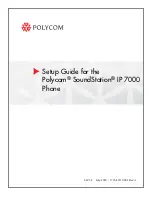
Installation
201
Installing the Processing Server (PS-1)
This section identifies the parts and processes, and describes the procedures for installing the
optional Processing Server (PS-1). The PS-1 can be deployed using one of two methods:
1.
as dedicated hardware
2.
as a virtual appliance (vApp)
About the PS-1
As a dedicated hardware component, the PS-1 is a Linux server that connects through a local area
network (LAN) to the HX Controller or CS Controller Base Server and provides call processing power
for the expanded-capacity system. For a functional description, see “Processing Server
Characteristics (Physical PS-1)” on
. For technical descriptions see the
chapter and “Network Environment Requirements” on
VMware recently introduced the vApp, a software solution optimized for the cloud Operating System
(OS). A vApp is a logical entity composed of one or more virtual machines, which can be managed
as a unit. The vApp specifies and encapsulates components of an application (such as the PS-1)
as well as the operational policies and service levels associated with it. The vApp gives application
owners (such as Mitel) a standard way to describe operational policies for an application, which the
cloud OS can consistently interpret and run. The vApp is a broad category of virtual applications
that are built by independent software vendors (ISVs), system integrators, value-added resellers,
and on-site IT administrators. See “Installing the Virtual Processing Server (vPS-1)“ on
for details about installing the PS-1 as a vApp.
By providing additional call processing power, the PS-1 (or vPS-1) allows the system to adequately
support more phones than the Base Server chassis in stand-alone mode. vPS-1 performance will
not to be any different to that of the Physical PS-1. The intention is to allow deployment onto a virtual
machine, but not to achieve more BHCC, or extra resources, or to allow more phones to be
connected.
Keyboards connected to a Physical PS-1 and keyboards used through a vSphere console will use
U.S. keyboard mappings. If you are using a keyboard from a different region, be aware that some
characters received at the PS-1 will not match what was pressed on the keyboard. The preference
is to use an ssh connection to a PS-1 to enter or change values that depend on specific characters
(for example changing a password or entering a command).
See the
MiVoice Office 250 Engineering Guidelines
for details on when a PS-1 (or vPS-1) might be
needed.
Essential PS-1 BIOS Settings
The Basic Input/Output System (BIOS) settings of the PS-1 have been customized to control
specifically the way the PS-1 software interacts with system hardware. Because the default BIOS
settings have been modified to allow the system to operate, the BIOS settings must remain as they
came from the factory.
Summary of Contents for MIVOICE OFFICE 250
Page 1: ...MiVoice Office 250 INSTALLATION AND ADMINISTRATION GUIDE RELEASE 6 3 SP3 ...
Page 24: ...MiVoice Office 250 Installation and Administration Guide xxiv ...
Page 29: ...Chapter 1 MiVoice Office 250 New Features ...
Page 54: ...MiVoice Office 250 Installation and Administration Guide 26 ...
Page 55: ...Chapter 2 Document Overview ...
Page 62: ...MiVoice Office 250 Installation and Administration Guide 34 ...
Page 63: ...Chapter 3 Product Description ...
Page 86: ...MiVoice Office 250 Installation and Administration Guide 58 ...
Page 87: ...Chapter 4 Specifications ...
Page 157: ...Chapter 5 Installation ...
Page 251: ...Installation 223 ...
Page 274: ...MiVoice Office 250 Installation and Administration Guide 246 4 Test for quality ...
Page 396: ...MiVoice Office 250 Installation and Administration Guide 368 ...
Page 397: ...Chapter 6 Reference ...
Page 416: ...MiVoice Office 250 Installation and Administration Guide 388 ...
Page 417: ...Appendix A Private Networking ...
Page 445: ...Appendix B Network IP Topology ...
Page 486: ...MiVoice Office 250 Installation and Administration Guide 458 ...
Page 487: ...Appendix C Open Source License Agreements ...
Page 506: ...MiVoice Office 250 Installation and Administration Guide 478 ...
Page 507: ...Appendix D Phones ...
















































